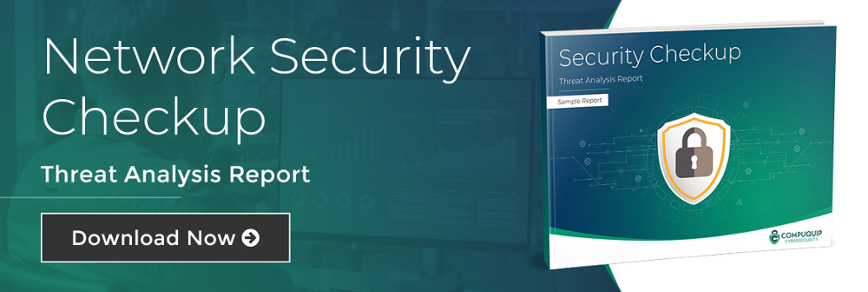Five Metrics to Increase the ROI of Penetration Testing
Cybercrime is projected to cost the world $10.5 trillion annually by 2025. How much will your company be impacted by that figure, and what can you do to minimize it? One method of fortifying your cybersecurity landscape is to conduct a penetration test. Since their inception, penetration tests have become a core cybersecurity service, helping organizations of all sizes and industries identify potential weak points in their network security architecture so they can be addressed before cyber-attacks can happen.
Learn more about the importance of penetration testing services and how these five metrics can help increase the benefits of a penetration test.
Quick Links:
- What is Penetration Testing?
- How Are Penetration Tests Performed?
- Five Metrics to Measure the ROI Value of Penetration Testing
- Enhance Your Penetration Testing with Compuquip Solutions
What is Penetration Testing?
A penetration test, colloquially known as a “pen test” or “ethical hacking”, is an authorized, simulated cyberattack on a computer system, performed to evaluate the security of the system. Penetration testing can involve the attempted breaching of any number of application systems, such as application protocol interfaces (APIs) or frontend/backend servers to uncover vulnerabilities.
This type of probe is akin to a bank hiring someone to dress as a burglar and try to break into their building in order to gain access to the vault. If the ‘burglar’ succeeds, the bank gains valuable information on how they need to tighten their security measures.

How Are Penetration Tests Performed?
There are typically five steps involved when performing a penetration test:
1. Planning and Reconnaissance
The first stage includes defining the scope and goals of a test, including the systems to be addressed and the testing methods to be used. Outlining these parameters and targeting different types of intelligence (e.g., network and domain names, mail server) results in a better understanding of how a target works and its potential vulnerabilities.
2. Scanning
The next step is to understand how the target application will respond to various intrusion attempts. This is typically done using either static or dynamic analysis.
- Static Analysis – Inspecting an application’s code to estimate the way it behaves while running; these tools can scan the entirety of the code in a single pass.
- Dynamic Analysis – Inspecting an application’s code in a running state, which is a more practical way of scanning that provides a real-time view into an application’s performance.
3. Gaining Access
This stage uses web application attacks, such as cross-site scripting, SQL injection, and backdoors, to uncover a target’s vulnerabilities. Ethical hackers then try to exploit these vulnerabilities, typically by escalating privileges, stealing data, and intercepting traffic to understand the full scope of damage they can cause with their access.
4. Maintaining Access
After gaining access, the hacker’s aim is to maintain their status within the target. The goal of this stage is to see if the vulnerability can be used to achieve a persistent presence in the exploited system— long enough for a bad actor to gain in-depth access and cause significant problems. The idea is to imitate advanced and persistent security breaches, which often remain in a system for months in order to steal an organization’s most sensitive data.
5. Analysis of the Penetration Test
The results of the penetration test are then compiled into a report that details the specific vulnerabilities that were successfully exploited, the variety of sensitive data that was accessed, the amount of time the pen tester was able to remain undetected in the system, and more. This information is analyzed by cybersecurity personnel to help configure an enterprise’s WAF settings and other application security solutions to patch vulnerabilities and protect against future attacks. A penetration test’s results might not be easy to handle, depending on the prevalence of weaknesses in your network, but such results are essential for moving forward with a solid cybersecurity plan.

Five Metrics to Measure the ROI Value of Penetration Testing
Metrics drive insight into the success and progress of your InfoSec program, which can help you set relevant performance indicators, showcase the value for funding your penetration testing program, and provide direction for future pen-testing. Without knowing the current status of your company’s cybersecurity landscape, you can’t make educated decisions about strengthening it.
Tracking All Measures of Risk
High-severity vulnerabilities are not the only things to worry about in a penetration test - attackers aim to exploit the most vulnerable at any severity level! These metrics highlight areas that are neglected or missing security investment. Be sure to track your trends at each severity level and across your portfolio of software assets to gather a comprehensive understanding of your company’s risks.
Review Top Vulnerability Density Trends
Vulnerability density is a normalized measure, given by the number of vulnerabilities per unit of code size. Any trend in vulnerability density is instrumental for business and risk insight. Historical data can help determine if identifying one vulnerability indicates the likely presence of multiple vulnerabilities. When trending down, this metric indicates better control over systems.
Ratio of Open: Remediated Vulnerabilities
This metric shows how fast and effective your organization is at remediating security issues. It can also highlight specific areas where training is needed to boost remediation. This metric is crucial for understanding your company’s current cybersecurity posture; in 2020, the average time to identify and contain a security breach was a staggering 280 days.
Determine Remediation Effort Costs
After quantifying how long it takes to remediate a vulnerability, factor in the cost of remediation. For example, vulnerabilities found in production will cost much more to remediate than vulnerabilities found in development. Multiply the hours spent on remediation times the personnel cost per hour to demonstrate how cost-effective it is to engage in penetration testing earlier in the SDLC.
Calculate Security Application Costs
Identify security requirements before coding, support code review in the software development lifecycle, and provide a vulnerability management tracking system integrated with your continuous integration and delivery (CI/CD) pipeline as software is promoted from one environment to another. Calculate how much these security applications will cost to gain further insight into your company’s cybersecurity posture.
Enhance Your Penetration Testing with Compuquip Solutions
As a dedicated managed security services provider for companies, Compuquip Cybersecurity has extensive experience with both automated and manual penetration tests. We use the latest techniques to evaluate your network systems and locate potential security gaps that could endanger your data and mission-critical applications.
To learn more about our vulnerability assessment and penetration testing services, contact our team today and tell us all about your organization’s unique cybersecurity needs.

